Occupational environment monitoring of a packaging manufacturing factory
99,000 ₫
Note: The above price is calculated for one sample, and the price may fluctuate depending on the area of the environment to be monitored and market movements. For more accurate pricing support, please refer to the price list or contact our consulting staff directly.
Monitoring the environment of a packaging manufacturing factory is a session of collecting, analyzing, and evaluating factors at the workplace that may harm workers health.
Table of Contents
Toggle1. Overview of Packaging Factories
a. What is a Packaging Factory?
A factory for packaging is a production facility that manufactures packaging equipment and materials. Its role is to produce packaging products such as carton boxes, bags, bottles, cans, and other types of packaging.
Packaging factories use processes and technologies to manufacture and print on packaging materials. Products created in packaging factories include consumer packaging, industrial packaging, and packaging for shipping and transportation.
Packaging factories may operate independently or as part of a larger company with various packaging production and supply activities.

b. Production Stages in a Packaging Factory
Production stages in a packaging factory may vary depending on the type of packaging and the production technology used. Below are some common stages in the packaging production process:
- Design and development: This stage involves creating packaging models and designs based on customer requirements. It may include using design software and tools to create prototypes and packaging samples.
- Material selection: Packaging materials such as paper, carton, plastic, and metal are selected and prepared for use in production. This may include procurement and quality inspection of materials.
- Material pre-treatment: Packaging materials may require pre-treatment processes such as cutting, processing, and printing to prepare for the main production process.
- Packaging production: The main production stage includes processes such as cutting, embossing, folding, gluing, welding, vacuum sealing, or molding to create final packaging products. The technology and equipment used vary depending on the type of packaging.
- Printing and finishing: If required, packaging can be printed with images, logos, product information, and other details. Finishing processes such as silver coating, UV coating, lamination, or other special treatments enhance aesthetics and protect the packaging.
- Packing and boxing: Finished packaging products are packed and boxed for transportation and delivery. This stage includes arranging, protective packing, and ensuring the safety of the packaging products.

c. Machinery Used in Packaging Factories
Common machinery used in packaging factories includes:
- Cutting machines: Used to precisely cut sheets of packaging materials such as paper, carton, or plastic into desired sizes and shapes.
- Embossing machines: Used to create patterns, logos, or raised lettering on packaging surfaces.
- Folding machines: Used to fold packaging components to form the final product shape.
- Gluing machines: Used to attach parts or seams of packaging to complete the product.
- Welding machines: Used to weld seams or edges of packaging using heat or pressure.
- Printing machines: Used to print images, logos, product information, and other details on the packaging surface.
- Molding machines: Used to create packaging products by pressing or molding materials like plastic into molds.
- Packing machines: Used to pack and seal packaging products into bags, boxes, or cartons.
- Quality inspection machines: Used to check accuracy, durability, and other quality factors of packaging products.
These are common examples of machinery in packaging factories; additional machines may be used depending on factory scale and technology.

d. Occupational Diseases for Workers in Packaging Factories
Workers in packaging factories may face various occupational diseases. Examples include:
- Respiratory issues: Exposure to dust, organic vapors, chemical fumes, and other substances can cause respiratory irritation, pneumonia, or respiratory diseases.
- Skin allergies: Contact with certain packaging materials such as chemicals, ink, or adhesives can lead to skin allergies, dermatitis, or eczema.
- Injuries: Production processes involving machinery and equipment pose risks of occupational accidents, including impacts, cuts, crushing, or injuries from materials and tools.
- Spinal and musculoskeletal problems: Repetitive and heavy tasks such as pulling, lifting, and transporting packaging can strain the spine, muscles, and joints.
- Hand and wrist issues: Repetitive tasks or hand-intensive work such as cutting, folding, and embossing can cause hand or wrist disorders, or polyneuropathy.
- Noise: Some machines in packaging factories produce high noise levels, affecting hearing and potentially causing hearing loss or related conditions.
To prevent occupational diseases, it is important to ensure safety and proper procedures. Packaging factories should comply with labor safety regulations, provide protective equipment, and train employees to safely operate machinery.

e. Products of Packaging Factories
Packaging factories produce a wide range of products. Common examples include:
- Carton boxes: Rigid cartons used to pack and protect products such as consumer goods, electronics, food, toys, and more.
- Packaging bags: Made from paper, plastic, non-woven fabric, or composite films. Used for packaging and transporting products like food, chemicals, clothing, and more.
- Bottles and cans: Plastic bottles, aluminum cans, or steel cans for beverages, cosmetics, liquids, and other products.
- Liquid bags: Specialized bags designed to hold and transport liquids such as water, oil, chemicals, or medical fluids. Typically made from waterproof materials like PE (polyethylene) or aluminum.
- Component and spare part packaging: Smaller packaging for electronics, machinery parts, or automotive components.
- Special packaging: Custom packaging such as anti-static, shockproof, waterproof, or other specialized packaging based on customer requirements.

2. Overview of Occupational Environment Monitoring Services
a. What is Occupational Environment Monitoring in Packaging Factories?
Occupational environment monitoring (or workplace environmental measurement) in packaging factories involves collecting, evaluating, and analyzing measurements of workplace environmental factors to take timely measures, reduce environmental harm to worker health, and prevent occupational diseases. This monitoring is mandatory for packaging factories.
Occupational environment monitoring is crucial for protecting and enhancing worker health, as workers are the main resource and directly generate profit for the company. Workers regularly exposed to hazards exceeding allowed limits may suffer health effects and occupational diseases.
REGISTER FOR OCCUPATIONAL ENVIRONMENT MONITORING SERVICE
b. Nam Viet’s Occupational Environment Monitoring Program
Nam Viet’s program is developed by monitoring engineers specializing in occupational safety and environmental protection. It uses modern measurement methods to monitor air, water, microclimate, physical factors, dust, and other workplace elements. This program ensures a safe working environment and protects worker health.
Additionally, Nam Viet’s program helps research and develop new solutions to improve workplace environmental quality. With the dedication and professionalism of its experts, Nam Viet’s exclusive monitoring program is a breakthrough in occupational safety and environmental management in Vietnam.

c. Standardization in Workplace Measurement Processes
Standardization ensures accuracy and reliability of measurement results. Nam Viet follows recognized standards and procedures from Ho Chi Minh City Department of Health, ensuring reliable data for evaluating and improving workplace conditions.
Standardized procedures ensure measurements are conducted by experienced monitoring professionals, allowing managers to trust results for informed decisions regarding worker health and environmental protection.
Implementing standardized procedures demonstrates Nam Viet’s commitment to a safe and healthy workplace and contributes to occupational safety and environmental management in Vietnam.
d. Reporting Results for Packaging Factories
Monitoring results follow Form 04, Appendix III of Decree 44/2016/ND-CP and are issued in two copies: one for the contracted factory and one kept by the monitoring organization.
Retention of monitoring results follows legal regulations with no expiration.

e. Frequency of Workplace Monitoring According to Law
According to Clause 2, Article 18 of Labor Safety and Hygiene Law 84/2015/QH13, employers must conduct occupational environment monitoring at least once a year.
f. Deadline for Submitting Monitoring Reports According to Law
Reports must be submitted before December 31 each year. Enterprises must submit monitoring reports to the local Department of Health where the production or business facility has its headquarters and where workers are employed.
When there are changes in technology, production processes, or facility upgrades that may introduce new hazardous factors, enterprises must update occupational hygiene records regarding the new factors requiring workplace monitoring.
g. Penalties for Violating Workplace Monitoring Regulations for Employers
According to Article 27 of Decree 12/2022/ND-CP dated 17/01/2022 on administrative penalties in labor, social insurance, and Vietnamese workers abroad:
- Clause 2: Fines of 2,000,000 – 5,000,000 VND for employers who do not publicly disclose monitoring results and hazard evaluations to workers immediately after results are available.
- Clause 3: Fines of 20,000,000 – 40,000,000 VND for employers who fail to conduct workplace monitoring to control health risks legally.
- Clause 4: Fines of 40,000,000 – 60,000,000 VND for employers who collude with monitoring organizations to falsify monitoring results without criminal liability.
3. Harmful Environmental Factors for Workers in Packaging Factories
Workers in packaging factories may encounter several harmful environmental factors. Below are some examples of environmental factors that may affect workers’ health:
- Dust: The production process in packaging factories can generate dust from materials such as paper, carton, plastic, or chemical compounds. Inhaling dust can cause respiratory irritation and other respiratory issues.
- Chemical fumes: The use of chemicals in packaging production can release chemical fumes into the air. Inhaling chemical fumes can cause irritation, dermatitis, respiratory problems, or affect overall health.
- Noise: Some machinery in packaging factories can produce high noise levels. Continuous and loud noise can damage hearing, cause stress, insomnia, or affect workers’ psychological well-being.
- Temperature and humidity: Certain production processes in packaging factories can create working environments with high temperature or high humidity. Uncomfortable environmental conditions can cause fatigue, dehydration, and reduced work performance.
- Mechanical impact: Due to production processes involving machinery and equipment, there is a risk of injury from impact, cutting, crushing, or handling of materials and tools.
- Lighting: Production processes in packaging factories may require strong artificial lighting or insufficient natural light. Improper light intensity or unsuitable lighting types can cause eye strain, difficulty concentrating, or affect vision.
REGISTER FOR OCCUPATIONAL ENVIRONMENT MONITORING SERVICE
4. Measures to Improve the Working Environment in Packaging Factories
To improve the working environment in packaging factories and protect workers’ health, the following measures can be applied:
- Ensure ventilation and fans: Provide ventilation systems and fans to reduce temperature and humidity in the factory. This improves comfort and reduces the risk of heat stress.
- Use dust extraction systems: Install effective dust extraction systems to remove dust from production processes. This reduces the likelihood of workers inhaling dust and lowers the risk of respiratory problems.
- Chemical control: Ensure the safe use of chemicals and comply with regulations regarding chemical usage. Provide appropriate personal protective equipment such as masks, gloves, and protective clothing to shield workers from chemical exposure.
- Sound and noise: Install soundproofing and insulation to reduce noise at the source or provide hearing protection for employees. Organize work schedules and breaks appropriately to minimize the impact of noise on health and psychological well-being.
- Training and education: Provide training on occupational safety, proper use of protective equipment, safe working procedures, and preventive measures against occupational diseases. Ensure that workers understand environmental risks in packaging factories and how to protect themselves.
- Regular inspection and maintenance: Conduct regular inspection and maintenance of machinery and equipment to ensure safe and efficient operation. This reduces the risk of occupational accidents and equipment failures.
- Periodically conduct occupational environment monitoring in factories, collect and analyze harmful factors for workers, and adjust to reduce risks to prevent occupational diseases.
5. Benefits of Periodic Monitoring in Packaging Factories
An Toan Nam Viet provides excellent benefits for businesses using occupational environment monitoring services in accordance with Decree 44/2016/ND-CP on managing and controlling harmful factors in the working environment affecting employees.
- Businesses can proactively control harmful factors in workshops or factories.
- Receive recommendations to minimize harmful factors and improve the quality of the working environment.
- Indirectly protect human resources, the key factor in business development.
- Reduce the impact of occupational diseases on health, thereby lowering future medical treatment costs.
- Enhance workers’ health, ensuring product quality and production output.
- Comply with labor safety regulations, avoiding legal risks.
- Build reputation and professionalism in all aspects, enhancing the enterprise’s brand.
Nam Viet’s occupational environment monitoring service is a solution to reduce the harm of occupational diseases, contributing to a clean and quality working environment.

6. National Occupational Environment Monitoring Center
Occupational Environment Monitoring Center of Nam Viet is a professional unit specializing in monitoring and measuring the quality of the working environment throughout all provinces in Vietnam. With an experienced team of monitoring specialists, the center uses modern measuring devices, ensuring accuracy and reliability.
Besides providing monitoring services, the center also supports clients in planning, handling, and tracking occupational environment issues. With the motto “customer-centric,” the center focuses on client satisfaction, meeting all needs, and committing to delivering the best solutions for businesses.
REGISTER FOR OCCUPATIONAL ENVIRONMENT MONITORING SERVICE
With investments in technology, equipment, and human resources, Nam Viet’s monitoring center has become a reputable unit in occupational environment monitoring in Ho Chi Minh City with the following goals:
- We always value brand reputation and the quality of our service products.
- We provide clients with the best and most suitable solutions.
- With a team of experienced Masters and Engineers aiming to protect the environment and benefit enterprises.
- By choosing Nam Viet’s Environmental Monitoring team, your company will receive professional service from experts in the field and the best cost incentives.
The occupational environment monitoring process at Nam Viet includes the following basic steps:
- Before performing monitoring, we ensure all machines and equipment are calibrated and adjusted according to legal regulations.
- Carry out the monitoring process fully and accurately as committed to the Department of Health.
- Honestly report the monitoring results to the employer.
- If the monitoring results indicate unsafe conditions for workers, Nam Viet will support solutions, and the workplace will implement as follows:
- Implement measures to improve working conditions to minimize harmful effects and prevent occupational diseases.
- Organize health check-ups to detect occupational and related diseases early for workers in unsafe positions.
- Provide material compensation to workers according to labor law.

7. Occupational Environment Monitoring Pricing
To help businesses carry out occupational environment monitoring professionally and efficiently, Nam Viet provides clients with a price list for occupational environment monitoring services that is high-quality and reasonably priced.
- Our pricing provides detailed information on the cost of the monitoring services we offer, including costs for travel, measurement, analysis, and reporting. Clients can trust the accuracy and reliability of our monitoring reports.
- We commit to offering the most competitive and reasonable prices on the market, and we are always ready to consult and answer any questions promptly and professionally.
- With Nam Viet’s pricing, clients can easily select service packages that suit their needs. We promise to provide the highest satisfaction with professional service quality.
1 review for Occupational environment monitoring of a packaging manufacturing factory
No comments yet

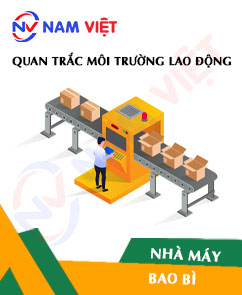
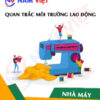
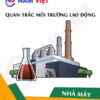
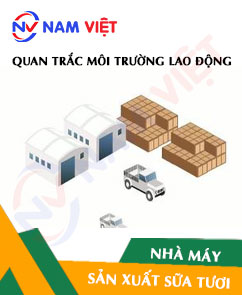
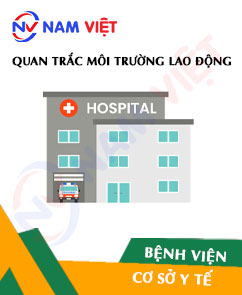
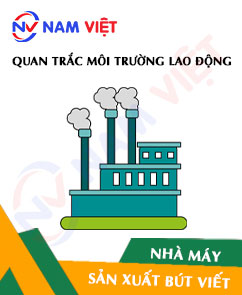

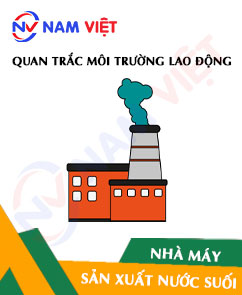



maituyet.cuong12
Good labor environment monitoring service!